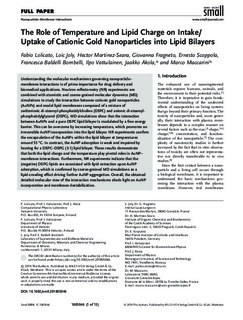| dc.contributor.author | Lolicato, Fabio | |
| dc.contributor.author | Joly, Loic | |
| dc.contributor.author | Martinez-Seara, Hector | |
| dc.contributor.author | Fragneto, Giovanna | |
| dc.contributor.author | Scoppola, Ernesto | |
| dc.contributor.author | Baldelli Bombelli, Francesca | |
| dc.contributor.author | Vattulainen, Ilpo | |
| dc.contributor.author | Akola, Jaakko | |
| dc.contributor.author | Maccarini, Marco | |
| dc.date.accessioned | 2020-02-05T09:06:57Z | |
| dc.date.available | 2020-02-05T09:06:57Z | |
| dc.date.created | 2019-08-06T17:00:44Z | |
| dc.date.issued | 2019 | |
| dc.identifier.citation | Small. 2019, 15 (23), 1-15. | nb_NO |
| dc.identifier.issn | 1613-6810 | |
| dc.identifier.uri | http://hdl.handle.net/11250/2639708 | |
| dc.description.abstract | Understanding the molecular mechanisms governing nanoparticle–membrane interactions is of prime importance for drug delivery and biomedical applications. Neutron reflectometry (NR) experiments are combined with atomistic and coarse‐grained molecular dynamics (MD) simulations to study the interaction between cationic gold nanoparticles (AuNPs) and model lipid membranes composed of a mixture of zwitterionic di‐stearoyl‐phosphatidylcholine (DSPC) and anionic di‐stearoyl‐phosphatidylglycerol (DSPG). MD simulations show that the interaction between AuNPs and a pure DSPC lipid bilayer is modulated by a free energy barrier. This can be overcome by increasing temperature, which promotes an irreversible AuNP incorporation into the lipid bilayer. NR experiments confirm the encapsulation of the AuNPs within the lipid bilayer at temperatures around 55 °C. In contrast, the AuNP adsorption is weak and impaired by heating for a DSPC–DSPG (3:1) lipid bilayer. These results demonstrate that both the lipid charge and the temperature play pivotal roles in AuNP–membrane interactions. Furthermore, NR experiments indicate that the (negative) DSPG lipids are associated with lipid extraction upon AuNP adsorption, which is confirmed by coarse‐grained MD simulations as a lipid‐crawling effect driving further AuNP aggregation. Overall, the obtained detailed molecular view of the interaction mechanisms sheds light on AuNP incorporation and membrane destabilization. | nb_NO |
| dc.language.iso | eng | nb_NO |
| dc.publisher | Wiley | nb_NO |
| dc.rights | Attribution-NonCommercial-NoDerivatives 4.0 Internasjonal | * |
| dc.rights.uri | http://creativecommons.org/licenses/by-nc-nd/4.0/deed.no | * |
| dc.title | The Role of Temperature and Lipid Charge on Intake/Uptake of Cationic Gold Nanoparticles into Lipid Bilayers | nb_NO |
| dc.type | Journal article | nb_NO |
| dc.type | Peer reviewed | nb_NO |
| dc.description.version | publishedVersion | nb_NO |
| dc.source.pagenumber | 1-15 | nb_NO |
| dc.source.volume | 15 | nb_NO |
| dc.source.journal | Small | nb_NO |
| dc.source.issue | 23 | nb_NO |
| dc.identifier.doi | 10.1002/smll.201805046 | |
| dc.identifier.cristin | 1714424 | |
| dc.description.localcode | © 2019 The Authors. Published by WILEY‐VCH Verlag GmbH & Co. KGaA, Weinheim This is an open access article under the terms of the Creative Commons Attribution‐NonCommercial‐NoDerivs License, which permits use and distribution in any medium, provided the original work is properly cited, the use is non‐commercial and no modifications or adaptations are made. | nb_NO |
| cristin.unitcode | 194,66,20,0 | |
| cristin.unitname | Institutt for fysikk | |
| cristin.ispublished | true | |
| cristin.fulltext | postprint | |
| cristin.qualitycode | 1 | |

